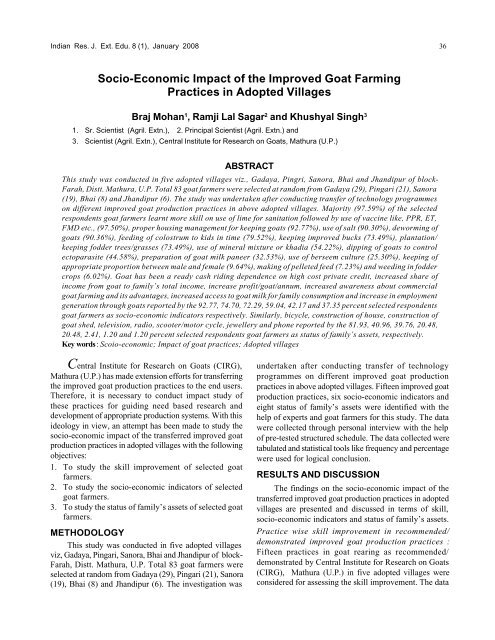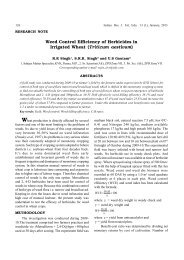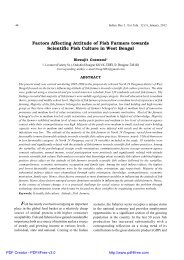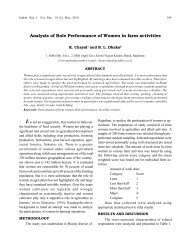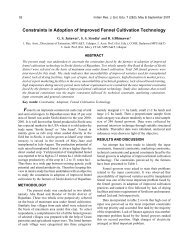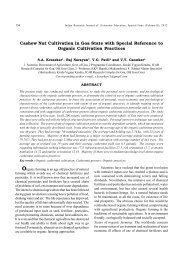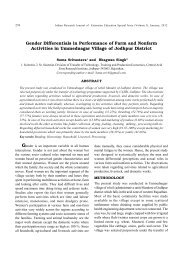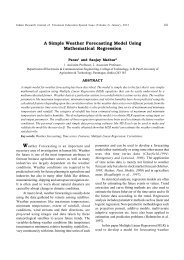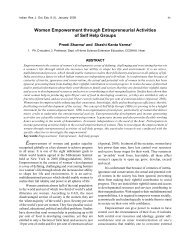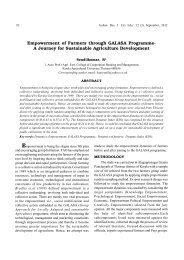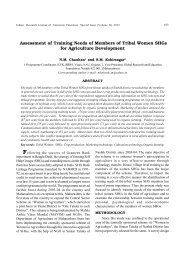Socio-Economic Impact of the Improved Goat Farming ... - Seea.org.in
Socio-Economic Impact of the Improved Goat Farming ... - Seea.org.in
Socio-Economic Impact of the Improved Goat Farming ... - Seea.org.in
Create successful ePaper yourself
Turn your PDF publications into a flip-book with our unique Google optimized e-Paper software.
Indian Res. J. Ext. Edu. 8 (1), January 2008 36<strong>Socio</strong>-<strong>Economic</strong> <strong>Impact</strong> <strong>of</strong> <strong>the</strong> <strong>Improved</strong> <strong>Goat</strong> <strong>Farm<strong>in</strong>g</strong>Practices <strong>in</strong> Adopted VillagesBraj Mohan 1 , Ramji Lal Sagar 2 and Khushyal S<strong>in</strong>gh 31. Sr. Scientist (Agril. Extn.), 2. Pr<strong>in</strong>cipal Scientist (Agril. Extn.) and3. Scientist (Agril. Extn.), Central Institute for Research on <strong>Goat</strong>s, Mathura (U.P.)ABSTRACTThis study was conducted <strong>in</strong> five adopted villages viz., Gadaya, P<strong>in</strong>gri, Sanora, Bhai and Jhandipur <strong>of</strong> block-Farah, Distt. Mathura, U.P. Total 83 goat farmers were selected at random from Gadaya (29), P<strong>in</strong>gari (21), Sanora(19), Bhai (8) and Jhandipur (6). The study was undertaken after conduct<strong>in</strong>g transfer <strong>of</strong> technology programmeson different improved goat production practices <strong>in</strong> above adopted villages. Majority (97.59%) <strong>of</strong> <strong>the</strong> selectedrespondents goat farmers learnt more skill on use <strong>of</strong> lime for sanitation followed by use <strong>of</strong> vacc<strong>in</strong>e like, PPR, ET,FMD etc., (97.50%), proper hous<strong>in</strong>g management for keep<strong>in</strong>g goats (92.77%), use <strong>of</strong> salt (90.30%), deworm<strong>in</strong>g <strong>of</strong>goats (90.36%), feed<strong>in</strong>g <strong>of</strong> colostrum to kids <strong>in</strong> time (79.52%), keep<strong>in</strong>g improved bucks (73.49%), plantation/keep<strong>in</strong>g fodder trees/grasses (73.49%), use <strong>of</strong> m<strong>in</strong>eral mixture or khadia (54.22%), dipp<strong>in</strong>g <strong>of</strong> goats to controlectoparasite (44.58%), preparation <strong>of</strong> goat milk paneer (32.53%), use <strong>of</strong> berseem culture (25.30%), keep<strong>in</strong>g <strong>of</strong>appropriate proportion between male and female (9.64%), mak<strong>in</strong>g <strong>of</strong> pelleted feed (7.23%) and weed<strong>in</strong>g <strong>in</strong> foddercrops (6.02%). <strong>Goat</strong> has been a ready cash rid<strong>in</strong>g dependence on high cost private credit, <strong>in</strong>creased share <strong>of</strong><strong>in</strong>come from goat to family’s total <strong>in</strong>come, <strong>in</strong>crease pr<strong>of</strong>it/goat/annum, <strong>in</strong>creased awareness about commercialgoat farm<strong>in</strong>g and its advantages, <strong>in</strong>creased access to goat milk for family consumption and <strong>in</strong>crease <strong>in</strong> employmentgeneration through goats reported by <strong>the</strong> 92.77, 74.70, 72.29, 59.04, 42.17 and 37.35 percent selected respondentsgoat farmers as socio-economic <strong>in</strong>dicators respectively. Similarly, bicycle, construction <strong>of</strong> house, construction <strong>of</strong>goat shed, television, radio, scooter/motor cycle, jewellery and phone reported by <strong>the</strong> 81.93, 40.96, 39.76, 20.48,20.48, 2.41, 1.20 and 1.20 percent selected respondents goat farmers as status <strong>of</strong> family’s assets, respectively.Key words : Scoio-economic; <strong>Impact</strong> <strong>of</strong> goat practices; Adopted villagesCentral Institute for Research on <strong>Goat</strong>s (CIRG),Mathura (U.P.) has made extension efforts for transferr<strong>in</strong>g<strong>the</strong> improved goat production practices to <strong>the</strong> end users.Therefore, it is necessary to conduct impact study <strong>of</strong><strong>the</strong>se practices for guid<strong>in</strong>g need based research anddevelopment <strong>of</strong> appropriate production systems. With thisideology <strong>in</strong> view, an attempt has been made to study <strong>the</strong>socio-economic impact <strong>of</strong> <strong>the</strong> transferred improved goatproduction practices <strong>in</strong> adopted villages with <strong>the</strong> follow<strong>in</strong>gobjectives:1. To study <strong>the</strong> skill improvement <strong>of</strong> selected goatfarmers.2. To study <strong>the</strong> socio-economic <strong>in</strong>dicators <strong>of</strong> selectedgoat farmers.3. To study <strong>the</strong> status <strong>of</strong> family’s assets <strong>of</strong> selected goatfarmers.METHODOLOGYThis study was conducted <strong>in</strong> five adopted villagesviz, Gadaya, P<strong>in</strong>gari, Sanora, Bhai and Jhandipur <strong>of</strong> block-Farah, Distt. Mathura, U.P. Total 83 goat farmers wereselected at random from Gadaya (29), P<strong>in</strong>gari (21), Sanora(19), Bhai (8) and Jhandipur (6). The <strong>in</strong>vestigation wasundertaken after conduct<strong>in</strong>g transfer <strong>of</strong> technologyprogrammes on different improved goat productionpractices <strong>in</strong> above adopted villages. Fifteen improved goatproduction practices, six socio-economic <strong>in</strong>dicators andeight status <strong>of</strong> family’s assets were identified with <strong>the</strong>help <strong>of</strong> experts and goat farmers for this study. The datawere collected through personal <strong>in</strong>terview with <strong>the</strong> help<strong>of</strong> pre-tested structured schedule. The data collected weretabulated and statistical tools like frequency and percentagewere used for logical conclusion.RESULTS AND DISCUSSIONThe f<strong>in</strong>d<strong>in</strong>gs on <strong>the</strong> socio-economic impact <strong>of</strong> <strong>the</strong>transferred improved goat production practices <strong>in</strong> adoptedvillages are presented and discussed <strong>in</strong> terms <strong>of</strong> skill,socio-economic <strong>in</strong>dicators and status <strong>of</strong> family’s assets.Practice wise skill improvement <strong>in</strong> recommended/demonstrated improved goat production practices :Fifteen practices <strong>in</strong> goat rear<strong>in</strong>g as recommended/demonstrated by Central Institute for Research on <strong>Goat</strong>s(CIRG), Mathura (U.P.) <strong>in</strong> five adopted villages wereconsidered for assess<strong>in</strong>g <strong>the</strong> skill improvement. The data
Indian Res. J. Ext. Edu. 8 (1), January 2008 37generated on this aspect were analysed and presented<strong>in</strong> Table 1.Table 1. Distribution <strong>of</strong> selected goat farmers accord<strong>in</strong>g toskill improvement <strong>in</strong> improved goat production practices(N= 83)S.No.Learnt more skill on f %1. Use <strong>of</strong> lime for sanitation. 81 97.592. Use <strong>of</strong> vacc<strong>in</strong>e like, PPR,ET,FMD etc. 81 97.593. Proper hous<strong>in</strong>g management for 77 92.77keep<strong>in</strong>g goats.4. Use <strong>of</strong> salt. 75 90.365. Deworm<strong>in</strong>g <strong>of</strong> goats. 75 90.366. Feed<strong>in</strong>g <strong>of</strong> colostrum to kids <strong>in</strong> time. 66 79.527. Keep<strong>in</strong>g improved bucks. 61 73.498. Plantation/keep<strong>in</strong>g <strong>of</strong> fodder trees/ 61 73.49grasses.9. Use <strong>of</strong> m<strong>in</strong>eral mixture or khadia. 45 54.2210. Dipp<strong>in</strong>g <strong>of</strong> goats to control 37 44.58ectoparasite.11. Preparation <strong>of</strong> goat milk Paneer. 27 32.5312. Use <strong>of</strong> Berseem culture. 21 25.3013. Keep<strong>in</strong>g <strong>of</strong> appropriate proportion 8 9.64between male and female.14. Mak<strong>in</strong>g <strong>of</strong> pelleted feed. 6 7.2315. Weed<strong>in</strong>g <strong>in</strong> fodder crops. 5 6.02It could be seen from Table1 that 15 practicesrecommended /demonstrated by Central Institute forResearch on <strong>Goat</strong>s, Mathura (U.P.) <strong>in</strong> goat rear<strong>in</strong>g <strong>in</strong>adopted villages. The majority <strong>of</strong> <strong>the</strong> selected respondentsgoat farmers learnt more skill on use <strong>of</strong> lime for sanitation(97.59%), use <strong>of</strong> vacc<strong>in</strong>e like, PPR, ET, FMD etc.,(97.59%), proper hous<strong>in</strong>g management for keep<strong>in</strong>g goats(92.77%), use <strong>of</strong> salt (90.36%), deworm<strong>in</strong>g <strong>of</strong> goats(90.36%), feed<strong>in</strong>g <strong>of</strong> colostrum to kids <strong>in</strong> time (79.52%),keep<strong>in</strong>g improved bucks (73.49%), plantation/ keep<strong>in</strong>g<strong>of</strong> fodder trees/grasses (73.49%) and use <strong>of</strong> m<strong>in</strong>eralmixture or khadia (54.22%). Anthalt (1994) reported that<strong>the</strong> skills are required by <strong>the</strong> extension agents to diagnosefarmers problems and <strong>the</strong> will<strong>in</strong>gness to do so effectively,listen to and learn from farmers and <strong>the</strong> will<strong>in</strong>gness to doso, communicate effectively with farmers and farmersgroups, present options based on pr<strong>in</strong>ciples <strong>of</strong> scienceand good agricultural practices which widen <strong>the</strong> realchoices available to farm families and work under complexand fluid circumstances with little supervision.The skill level seemed to be poor <strong>in</strong> <strong>the</strong> areas <strong>of</strong>dipp<strong>in</strong>g <strong>of</strong> goats to control ectoparasite preparation <strong>of</strong>goat milk paneer, use <strong>of</strong> berseem culture, keep<strong>in</strong>g <strong>of</strong>appropriate proportion between male and female, mak<strong>in</strong>g<strong>of</strong> pelleted feed and weed<strong>in</strong>g <strong>in</strong> fodder crops. Tra<strong>in</strong>abilityrefers to a person’s ability to acquire <strong>the</strong> skills, knowledgeor behaviour necessary to perform a job at a given leveland to achieve <strong>the</strong>se outcomes <strong>in</strong> a given time (Robertsonand Downs, 1979).<strong>Socio</strong>-economic <strong>in</strong>dicatorsThe socio-economic <strong>in</strong>dicators <strong>of</strong> selectedrespondents goat farmers were selected, tabulated andpresented <strong>in</strong> Table 2.Table 2. Distribution <strong>of</strong> selected goat farmers with respectto socio-economic <strong>in</strong>dicators (N=83)S.No.Particulars f %1. <strong>Goat</strong> has been a ready cash rid<strong>in</strong>g 77 92.77dependence on high cost private credit.2. Increased share <strong>of</strong> <strong>in</strong>come from goat to 62 74.70family’s total <strong>in</strong>come.3. Increase pr<strong>of</strong>it/goat /annum. 60 72.294. Increased awareness about commercial 49 59.04goat farm<strong>in</strong>g and its advantages.5. Increased access to goat milk for family 35 42.17consumption.6. Increase <strong>in</strong> employment generation 31 37.35through goats.It is clear from Table 2 that majority <strong>of</strong> <strong>the</strong> selectedrespondents goat farmers (92.77%) reported that goathas been a ready cash rid<strong>in</strong>g dependence on high costprivate credit followed by <strong>in</strong>creased share <strong>of</strong> <strong>in</strong>come fromgoat to family’s total <strong>in</strong>come (74.70%), <strong>in</strong>crease pr<strong>of</strong>it/goat/ annum (72.29%), <strong>in</strong>creased awareness aboutcommercial goat farm<strong>in</strong>g and its advantages (59.04%),<strong>in</strong>creased access to goat milk for family consumption(42.17%) and <strong>in</strong>crease <strong>in</strong> employment generation throughgoats (37.35%). Kumar and S<strong>in</strong>gh (2005) also observedthat <strong>the</strong> goats have become steadily important <strong>in</strong> <strong>the</strong> ruraleconomy particularly <strong>in</strong> <strong>the</strong> arid, semi-arid andmounta<strong>in</strong>ous regions <strong>of</strong> <strong>the</strong> country. Similarly, goatprovided an opportunity for efficient utilization <strong>of</strong> familylabour (Kumar and Deoghare, 2003).Status <strong>of</strong> family’s assets : The status <strong>of</strong> family’s assets<strong>of</strong>selected respondents goat farmers presented<strong>in</strong> Table 3.Table 3. Distribution <strong>of</strong> goat farmers based on status <strong>of</strong>family’s assets (N=83)S.No. Particulars f %1. Bicycle. 68 81.932. Construction <strong>of</strong> house. 34 40.963. Construction <strong>of</strong> goat shed. 33 39.764. Television. 17 20.485. Radio. 17 20.486. Scooter /Motor Cycle. 2 2.417. Jewellery. 1 1.208. Phone. 1 1.20It may be seen from <strong>the</strong> Table 3 that 81.93 percent<strong>of</strong> <strong>the</strong> selected respondents goat farmers had possessedbicycle and construction <strong>of</strong> house and goat shed reported
Indian Res. J. Ext. Edu. 8 (1), January 2008 38by 40.96 and 39.76 percent, respectively. 20.48 percent<strong>of</strong> each possessed television and radio. There were fewerrespondents hav<strong>in</strong>g scooter/motor cycle, jewellery andphone. Acharya and S<strong>in</strong>gh (1992) also highlighted <strong>the</strong>crucial role <strong>of</strong> <strong>the</strong> goats <strong>in</strong> livelihood security <strong>of</strong> resourcepoor rural households.CONCLUSIONThe study <strong>in</strong>dicated that recommended /demonstratedpractices <strong>in</strong> goat rear<strong>in</strong>g, <strong>the</strong> majority <strong>of</strong> <strong>the</strong> selectedrespondents goat farmers learnt more skill on use <strong>of</strong> limefor sanitation, use <strong>of</strong> vacc<strong>in</strong>e like, PPR, ET, FMD etc.,proper hous<strong>in</strong>g management for keep<strong>in</strong>g goats, use <strong>of</strong>salt, deworm<strong>in</strong>g <strong>of</strong> goats, feed<strong>in</strong>g <strong>of</strong> colostrum to kids <strong>in</strong>time, keep<strong>in</strong>g improved bucks, plantation/ keep<strong>in</strong>g <strong>of</strong>fodder trees/ grasses and use <strong>of</strong> m<strong>in</strong>eral mixture or khadia.In <strong>the</strong> case <strong>of</strong> socio-economic <strong>in</strong>dicators, majority <strong>of</strong> <strong>the</strong>selected respondents goat farmers had reported that <strong>the</strong>goat has been a ready cash rid<strong>in</strong>g dependence on highcost private credit, <strong>in</strong>creased share <strong>of</strong> <strong>in</strong>come from goatto family’s total <strong>in</strong>come, <strong>in</strong>crease pr<strong>of</strong>it/goat/annum and<strong>in</strong>creased awareness about commercial goat farm<strong>in</strong>g andits advantages. Most <strong>of</strong> <strong>the</strong> selected respondents goatfarmers (81.93%) had possessed bicycle as status <strong>of</strong>family’s asset.REFERENCES1. Acharya, R.M. and S<strong>in</strong>gh, N.P. (1992). The Role <strong>of</strong> <strong>Goat</strong>s <strong>in</strong> Conservation <strong>of</strong> Ecology and Livelihood Security. Pre-ConferenceProceed<strong>in</strong>gs, V International Conference on <strong>Goat</strong>s, pp: 81-99.2. Anthalt, C.H. (1994). Gett<strong>in</strong>g Ready for <strong>the</strong> Twenty-First Century: Technical, Change and Institutional Modernization <strong>in</strong> AgricultureWorld Bank, Wash<strong>in</strong>gton, D.C.3. Kumar, S. and S<strong>in</strong>gh, N.P. (2005). <strong>Economic</strong>s <strong>of</strong> Small Rum<strong>in</strong>ant Production <strong>in</strong> Dry Regions. National Symposium <strong>of</strong> RMSI on“Augment<strong>in</strong>g Forage Resources <strong>in</strong> Arid and Semi-arid Region: Long Term Strategies” at Jaipur on November 19-20, pp : 489-498.4. Kumar, S. and Deoghare, P.R. (2003). <strong>Goat</strong> Production System and Livelihood Security <strong>of</strong> Rural Landless Households. Indian Journal<strong>of</strong> Small Rum<strong>in</strong>ants, 9 (1): 19-24.5. Robertson, I. and Dawns, S. (1979). Learn<strong>in</strong>g and <strong>the</strong> Prediction <strong>of</strong> Performance. Development <strong>of</strong> Tra<strong>in</strong>ability Test<strong>in</strong>g <strong>in</strong> <strong>the</strong> UnitedK<strong>in</strong>gdom, J. Appl. Psychol., 64: 42-50.


